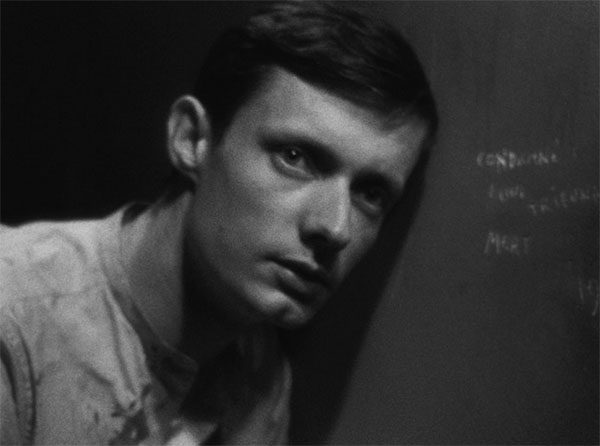“Robert Bresson’s A Man Escaped (1956) is generally considered one of the greatest prison-break movies ever made,” begins Tony Pipolo, writing for Criterion. “Except for the opening scene and the final shots, the entire film is set in the interiors and exteriors of a prison, modeled on the original, and follows the detailed activities of Fontaine (François Leterrier), the protagonist, as he prepares for what everyone tells him is an impossible feat…. The film’s brilliant exposition of Fontaine’s daily efforts to convert the objects in his cell into the instruments of escape indeed became for Bresson the expressive means for the man’s pragmatic form of faith.” See also Pipolo‘s 2011 piece on Bresson for Artforum and Jonathan Rosenbaum‘s 2010 review of Pipolo’s Robert Bresson: A Passion for Film.
“A Man Escaped is so absorbing because Bresson’s traditional methods of de-emphasis imbue the film with an almost maddening tension,” writes Chuck Bowen in Slant. “The prisoner’s panic and desperation is felt, but rarely seen. We can barely read Fontaine’s emotions because he can’t afford to allow them to distract from the task at hand, and so the details of Fontaine’s preparation for escape come to be imbued with a pregnant, repressed urgency as well as an ironic beauty; large sequences of a door being gradually chipped open are more suspenseful than any ultra-violent action extravaganza. Fontaine is saved by the cleansing power of precise, detailed work, of pride in craft, and for that he earns the grace note that occurs at the end of the film.”
“Wondrous indeed the film which is both perfect and great; rarer still the film whose perfection derives from a deliberate minimalism and severe reduction of expression.” In the Fall/Winter 2010-11 issue of Cerise Press, Jose-Luis Moctezuma argues that A Man Escaped “is one of those rare instances of a work whose greatness is directly characterized by its mechanisms of refinement; the film does not so much present a sheen of indisputable perfection as it reveals the hidden engine by which its nature produces a kinema of inward and outer symmetry. The risks taken in A Man Escaped—ordinary in themselves, but extraordinary in conjunction—are the same risks which characterize the whole esprit of Bresson’s oeuvre. The risk, namely, of opting for counter-intuitive narrative techniques when more conventional ones present themselves.”
Bill Ryan finds A Man Escaped to be “Bresson’s least mysterious” film: “L’Argent [1983] I suppose would be the Advanced Studies course, and A Man Escaped the 101 class, which is not a comment in any way on its achievement.”
“It’s beautiful, almost meditative, and strangely rousing, a drama where the slightest gesture carries the weight of a confession,” writes Sean Axmaker.
Along with their “Three Reasons,” Criterion’s posted Kate Elmore‘s “10 Things I Learned,” sort of an annotated photo gallery, and a clip (3’51”) from an essay by David Bordwell and Kristin Thompson on Bresson’s use of sound in A Man Escaped taken from Film Art: An Introduction. You can read the entire essay here.
“The supplements have such tremendous value, and along with the improved contrast of the 1080P image, make this one of the most attractive releases of the year,” argues Gary W. Tooze at DVD Beaver.
More? Alt Screen posted an excellent roundup on A Man Escaped in 2012.
For news and tips throughout the day every day, follow @KeyframeDaily on Twitter and/or the RSS feed. Get Keyframe Daily in your inbox by signing in at fandor.com/daily.




